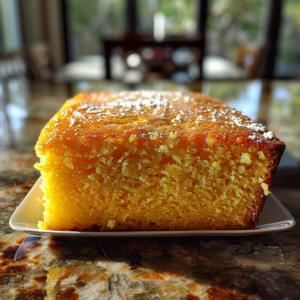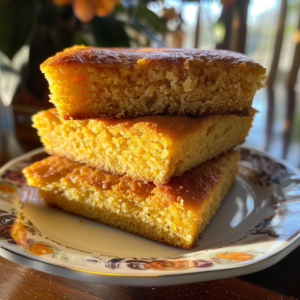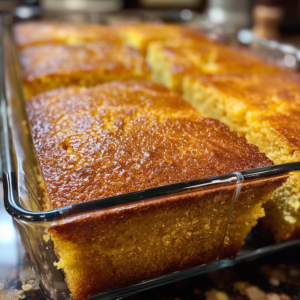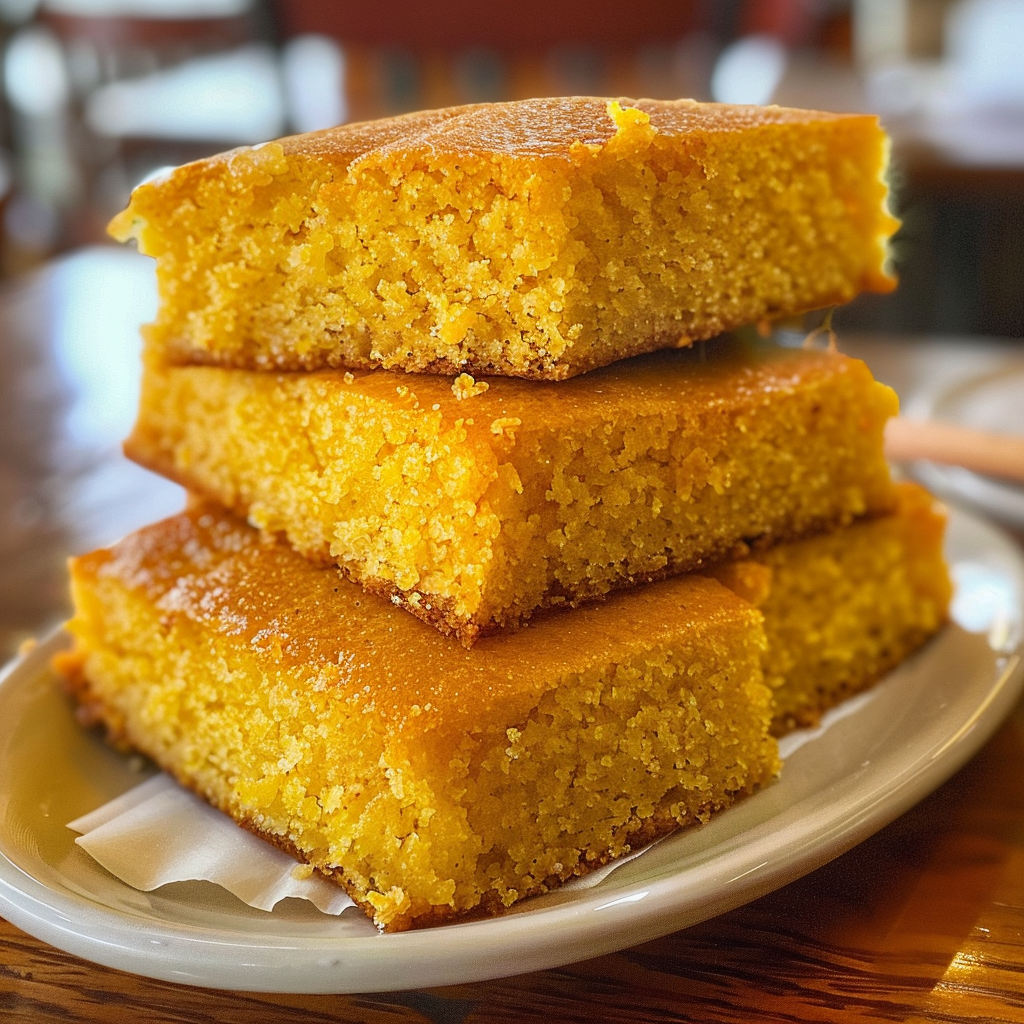Sweet Southern Cornbread is a beloved staple in Southern cuisine, epitomizing comfort and tradition. It’s more than just a side dish; it’s a symbol of family gatherings and hearty meals. In this article, we delve into the essence of Sweet Southern Cornbread, exploring its origins, variations, and the secrets to making it just right. From the classic ingredients that give it its distinctive taste to modern twists that add an exciting flair, we cover it all. So, buckle up and get ready to experience the rich flavors and stories behind this iconic Southern delicacy.
What is Sweet Southern Cornbread?
Sweet Southern Cornbread, often simply called cornbread, is renowned for its delightful texture and flavor, which can vary from crumbly and moist to fluffy and light. Traditionally baked in a cast-iron skillet, which imparts a uniquely crispy edge that is highly prized among cornbread aficionados, this bread forms an integral part of many Southern meals.
Historical Significance
Cornbread has roots deep in American history, particularly in the South, where corn was more prevalent than wheat. This accessibility made cornbread an economical choice during times of economic hardship, especially during the Civil War. It has since evolved but continues to be a comforting link to the past for many Southern families.
Regional Variations
While cornbread is a Southern staple, variations exist from one state to another, igniting a bit of a friendly debate. For instance, some swear by a sweeter version, adding sugar or honey, while others prefer a more savory flavor, focusing on the natural sweetness of corn. This division even extends to the type of cornmeal used, from stone-ground to finely milled.
The versatility of cornbread allows it to be served in various ways, be it alongside chili or as a base for stuffing. Whether you’re a fan of the sweet flavor that characterizes Sweet Southern Cornbread or prefer the traditional, less sweet versions, there’s no denying that each style has its charm and legion of supporters.
By exploring the historical roots and regional preferences, we gain not only an appreciation for this humble dish but also insights into the culture that surrounds it. As we continue, we’ll look into the essential ingredients that make up traditional and modern cornbread recipes, ensuring that you can bring a taste of the South into your kitchen.

Ingredients and Recipe Variations for Traditional cornbread
Creating the perfect Sweet Southern Cornbread starts with understanding the basic ingredients that form its foundation. While the recipe allows for flexibility, certain elements are essential to capture the authentic taste that makes this dish a Southern favorite.
Essential Ingredients
At its core, cornmeal is the star of the show, providing the distinctive grainy texture and sweet corn flavor that defines cornbread. To this, you typically add flour, which helps to bind the mixture and soften the texture, and leavening agents like baking powder or soda, which are crucial for that desirable lift and fluffiness.
Optional Add-ins for Flavor
To jazz up your cornbread, consider incorporating add-ins that can enhance its flavor profile. Some popular choices include:
- Fresh corn kernels for a burst of sweetness and texture
- Jalapeños or green chilies for a spicy kick
- Cheese for a gooey, melty experience
- Consider adding aromatic herbs such as rosemary or thyme for a fragrant enhancement.
Each addition can transform the basic recipe into something special, reflecting personal tastes or the theme of a meal.
Recipe Variations
Now, let’s talk variations! The debate between sweet and savory cornbread is ongoing, but why not explore both? For a sweet cornbread, adding sugar or honey can create a delightful contrast with spicy foods like chili or barbecue. On the other hand, a more traditional savory cornbread might include bacon fat or buttermilk, enhancing its compatibility with soups and stews.
Moreover, modern takes on this classic might incorporate gluten-free or plant-based ingredients, making it accessible to everyone at the dinner table. Experimenting with different types of milk, fats, and even vegan egg substitutes can yield surprising and delicious results.
By exploring these variations, you can tailor your cornbread to suit any occasion or palate, making it a versatile addition to your culinary repertoire. Up next, we’ll delve into the best cooking techniques to ensure your cornbread is perfect every time, from skillet to table. explore this Sweet Potato Cornbread recipe for a cozy twist
Cooking Techniques for Sweet Southern Cornbread
Mastering the art of making Sweet Southern Cornbread involves more than just mixing the right ingredients. The cooking method you choose can significantly impact the texture and flavor of the final product. Here’s how to get that perfect bake every time, whether you’re sticking with tradition or trying something new.
Traditional Methods
The quintessential way to cook cornbread is in a preheated cast-iron skillet. This method not only imparts a crisp, golden crust but also evenly distributes heat for a consistent texture throughout. To achieve the best results:
- Heat the skillet in the oven as it preheats to ensure the batter sizzles as soon as it hits the pan, creating that beloved crust.
- Pour the batter into the hot skillet and listen for that satisfying sizzle—this is key to achieving the characteristic crust that Southern cooks covet.
Modern Approaches
While traditional methods hold a special place in Southern hearts, modern kitchen appliances have introduced new ways to enjoy cornbread:
- Baking in a standard oven using a baking dish or muffin tins can produce soft, evenly baked cornbread that’s ideal for feeding a crowd or portion control.
- Some adventurous cooks even use air fryers or slow cookers to make cornbread, finding that these methods offer convenience and texture variations that are hard to achieve with standard ovens.
Tips for Perfect Cornbread
Regardless of the method, a few tips can ensure your cornbread is delightful:
- Do not overmix the batter. Mix just until the dry ingredients are moistened, as overmixing can lead to tough cornbread.
- Consider the sweetness and moisture levels. Adjust sugar and liquid ingredients according to your preference for sweetness and whether you like your cornbread moist or crumbly.
Perfecting your cooking technique will make your cornbread a guaranteed hit at any table. As we move forward, we’ll explore the vital role cornbread plays in Southern cuisine, from its place at the dinner table to its cultural significance.

Cornbread in Southern Cuisine
Cornbread is more than just a side dish in the South; it’s a versatile staple that complements a variety of meals, embodying the spirit and traditions of Southern cooking. Let’s explore how this simple bread serves as both a culinary and cultural cornerstone.
Role in Meals
In Southern homes, cornbread frequently accompanies a range of dishes, from savory stews and hearty chili to lighter fare like salads and greens. Its ability to pair well with both the bold flavors of smoked meats and the subtle tastes of fresh vegetables makes it indispensable at any meal. Whether used to sop up flavorful juices or enjoyed with a slather of butter, cornbread serves as the perfect side that enhances every dish.
Pairings with Dishes
Sweet Southern Cornbread shines when served alongside classic Southern dishes. Here are a few iconic pairings:
- Chili: The sweetness of the cornbread balances the spicy heat of the chili, making for a harmonious blend.
- Barbecue: A slice of cornbread is the perfect companion to barbecue, ready to absorb the rich, smoky sauces.
- Collard Greens: The bread’s subtle sweetness complements the earthy bitterness of greens, rounding out the flavors.
These pairings not only highlight the versatility of cornbread but also its role in enhancing the overall dining experience.
Cultural Impact
Cornbread holds a cherished place in Southern culture. It’s often at the center of holiday tables and family gatherings, symbolizing warmth and hospitality. Furthermore, cornbread competitions and festivals are common in the South, where variations of the bread are celebrated and savored, showcasing the rich culinary diversity of the region.
The cultural significance of cornbread extends beyond its culinary uses; it is a symbol of Southern identity and pride. Its simple ingredients and humble origins echo the values of Southern hospitality—sharing what you have with love and generosity.
As we delve deeper into the nuances of this beloved dish, we will next examine the ongoing debate within the South about whether cornbread should be sweet or savory—a topic that stirs as much passion as any classic Southern rivalry.
The Great Cornbread Debate
The debate over whether cornbread should be sweet or savory is a heated topic in Southern kitchens. This culinary controversy not only sparks lively discussions at dinner tables and cooking competitions but also reflects the diverse palates and traditions that make Southern cooking so rich and varied.
Sweet vs. Savory
In many Southern families, the preference for sweet or savory cornbread can be a point of familial pride, passed down through generations. Sweet cornbread, often enriched with sugar or honey, tends to be more popular in the “Upper South,” while savory cornbread, which eschews sugar for the natural flavor of corn, is a staple in the “Deep South.”
- Sweet Cornbread: Often seen as a nod to the modern palate, sweet cornbread pairs beautifully with spicy foods, offering a counterbalance to dishes with heat.
- Savory Cornbread: Traditionalists argue that savory cornbread, made with just cornmeal, salt, buttermilk, and perhaps a bit of fat, is the true Southern standard, perfect for absorbing the flavors of the accompanying meal.
Cornbread in Competitions
Cornbread competitions are a fixture at many Southern festivals, where enthusiasts gather to showcase their recipes, hoping their version wins the title of “best cornbread.” These events are not only a celebration of cornbread but also an exhibition of personal and regional tastes, with contestants often using secret ingredients or techniques handed down through their families.
Differing Opinions Across States
The cornbread debate often reflects deeper regional identities and cooking styles. For instance, in Tennessee, you might find a sweeter cornbread that could almost double as a dessert, whereas in Mississippi, the cornbread might be so savory and dense that it’s almost meal-like in itself.
This ongoing debate ensures that cornbread remains a dynamic and discussed element of Southern cuisine, continually adapting and evolving while still staying rooted in tradition. As we continue, we’ll explore practical tips and insights on how you can master the art of cornbread making in your own kitchen, ensuring that no matter which side of the debate you lean towards, your cornbread will be a hit.

Making Traditional cornbread at Home
Making Sweet Southern Cornbread at home is an enjoyable and rewarding endeavor. With a few tips and tricks, you can bake cornbread that rivals even the best Southern kitchens, perfecting both sweet and savory versions according to your preference.
Step-by-Step Guide
Here’s a straightforward guide to making classic Southern-style cornbread:
- Preheat your oven and place a cast-iron skillet inside to heat while you mix your ingredients. This step is crucial for achieving that desirable crispy crust.
- Combine dry ingredients—typically cornmeal, flour, baking powder, and salt—in one bowl. In another, mix wet ingredients like buttermilk, eggs, and oil or melted butter.
- If you’re making sweet cornbread, add sugar or honey to your wet ingredients; for savory, you might add a bit of finely chopped jalapeño or shredded cheese.
- Remove the hot skillet from the oven, coat it lightly with oil or butter, and then pour in the batter. The sizzle as the batter hits the skillet is a sign you’re on the right track.
- Cook until it turns a golden brown and a toothpick inserted into the middle comes out clean. This usually takes about 20-25 minutes, depending on your oven and the size of your skillet.
Common Mistakes
Avoid these common pitfalls to ensure your cornbread turns out perfectly every time:
- Overmixing the batter: This can make the cornbread tough. Just mix until the ingredients are combined.
- Skipping the preheat: Not preheating your skillet won’t give you that classic crust that’s so beloved in Southern cornbread.
- Using cold ingredients: Room temperature ingredients mix better and cook more evenly, so always allow your eggs and buttermilk to warm up a bit before mixing.
Making Cornbread with Kids
Cornbread is also a great recipe to make with children. It’s simple enough for them to help out, and they can see the results of their work fairly quickly. Plus, they’ll love getting to make their own additions like sweet corn kernels or tiny pieces of ham for a savory touch.
Making your own cornbread at home allows you to control the flavors and ingredients, adapting the recipe to meet your family’s tastes. Whether you prefer it sweet, savory, or somewhere in between, homemade cornbread is a satisfying addition to any meal. As we move forward, let’s take a closer look at the options available for those who prefer the convenience of store-bought mixes and how to choose the best one.
Store-Bought Cornbread Mixes
For those times when homemade isn’t feasible or when convenience is key, store-bought cornbread mixes can be a great alternative. There’s a variety of brands and flavors available, each offering a quick pathway to delicious cornbread with minimal effort.
Review of Popular Mixes
Several brands stand out in the world of cornbread mixes for their quality and flavor:
- Jiffy Corn Muffin Mix: This classic choice is beloved for its affordability and consistent results. It leans towards the sweeter side, making it a favorite for those who enjoy sweet cornbread.
- Bob’s Red Mill Gluten-Free Cornbread Mix: A great option for those with dietary restrictions, this mix is praised for its moist texture and delicious taste that doesn’t compromise on flavor.
- Krusteaz Southern Cornbread Mix: Known for its rich, buttery flavor and versatility, Krusteaz offers a mix that can be adjusted for either sweet or savory preparations.
Choosing the Right Mix
When selecting a cornbread mix, consider the following:
- Flavor Profile: Decide whether you want a sweeter mix or something that allows for more savory customizations.
- Texture Preferences: Some mixes produce a denser cornbread, while others are lighter. Check the label and reviews to see if a mix matches your texture preference.
- Dietary Needs: For those with specific dietary requirements, look for gluten-free, organic, or non-GMO mixes that cater to these needs.
Customizing Store-Bought Mixes
Even with a store-bought mix, you can add your personal touch to make the cornbread uniquely yours. Here are some ideas:
- Add-Ins: Incorporate fresh corn, jalapeños, cheese, or herbs to enhance the flavor.
- Toppings: Before baking, sprinkle the top with a blend of cheeses or a light dusting of sugar for extra flavor and texture.
- Replacement Ingredients: Substitute milk or buttermilk for water in the mix to enrich the flavor and improve the texture.
Using a store-bought mix doesn’t mean you have to sacrifice quality or creativity. With the right enhancements, you can transform a simple mix into a gourmet accompaniment to any meal. This approach not only saves time but also allows for flexibility in the kitchen, ensuring that you can enjoy delicious cornbread any day of the week.
FAQs About Sweet Southern Cornbread
Answering frequently asked questions about Sweet Southern Cornbread can help clarify common uncertainties and provide valuable tips for perfecting this beloved dish. Here are some of the most common inquiries:
Can cornbread be made without eggs?
Yes, cornbread can be made without eggs. To achieve a similar texture, you can use substitutes like applesauce, mashed bananas, or commercial egg replacers. Each substitute can also add a unique flavor, so it’s worth experimenting to find what works best for your taste.
How can I keep my cornbread from becoming overly dry?
Dry cornbread is often a result of overbaking or not enough fat in the batter. To prevent this, make sure to check your cornbread a few minutes before the timer goes off since oven temperatures can vary. Also, adding a bit more butter or oil can help keep it moist. Another tip is to include buttermilk or sour cream in your recipe, which adds moisture and a slight tanginess.
Is it better to use yellow or white cornmeal?
The choice between yellow or white cornmeal comes down to personal preference and regional tradition. Yellow cornmeal typically gives a richer, buttery flavor with a golden color, while white cornmeal tends to be slightly sweeter and produces a lighter-colored bread. Both types can be used to make delicious cornbread, so try both and see which you prefer.
Can cornbread be made in advance?
Absolutely! Cornbread can be baked ahead of time and stored. To keep it moist, wrap it tightly in plastic wrap or store it in an airtight container. It can be kept at room temperature for a day or two, or frozen for longer storage. When ready to serve, gently reheat it in the oven or microwave to refresh its flavor and texture.
What is the best way to reheat cornbread?
To reheat cornbread and maintain its moisture, wrap it in aluminum foil and place it in a preheated oven at about 350°F for about 10-15 minutes. If you’re in a hurry, you can microwave slices of cornbread on a microwave-safe plate, covered with a damp paper towel, for about 20-30 seconds.
These FAQs not only enhance your understanding but also improve your skills in making and serving cornbread, ensuring every slice is as delightful as the last. With these tips and tricks, you’re well-equipped to tackle any cornbread challenge, from choosing the right ingredients to serving it up in style. Whether it’s for a family dinner, a festive gathering, or a quiet meal, cornbread is a timeless favorite that brings warmth and happiness to any table.

